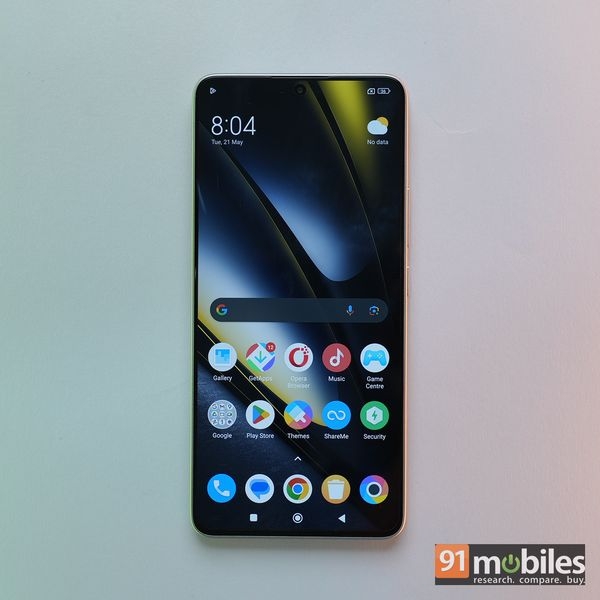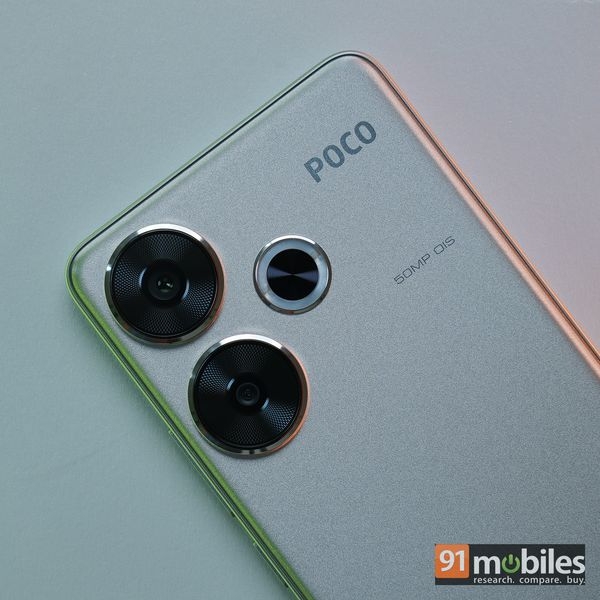Review Summary
Expert Rating
The POCO F6, the successor to the impressive F5, has big shoes to fill. The POCO F5 (review) set a high standard, and the F6 aims to surpass it with the newly-introduced Snapdragon 8s Gen 3 SoC, built on the same framework as Qualcomm’s flagship chipset. Along with this, the POCO F6 has been introduced with the fastest-ever charging solution and the highest display peak brightness for an F-series smartphone. How do all these enhancements shape the smartphone in the real world? And can they provide the F-series device with an edge over its competitors such as iQOO Neo 9 Pro (review) and Realme GT 6T (review)? The answers to all those questions lie in this POCO F6 review. Keep reading.
Table of Contents
Verdict
Design and display

The POCO F6 design remains largely unchanged from last year’s F-series offering. The handset features the same plastic unbody design with flat edges and individual camera rings. However, those camera rings have a slightly bigger footprint and jut out of the frame even more. Additionally, the glossy back has been replaced with a shimmery panel with texture to keep fingerprints and smudges at bay. While I appreciate the changes, I think it lacks the panache that some of the other similarly-priced phones bring to the table.
Be that as it may, with its 179-gram weight, the handset is extremely lightweight and comfortable to wield for prolonged usage. The IP rating of the phone has been upgraded from 53 to 64, making it more durable against water and dust. The F6 sports a dual speaker system fine-tuned by Dolby Atmos for a crisp audio experience. The 3.5mm headphone jack, which was there in last year’s offering, has been ditched this time around. For security, the phone boasts an in-display fingerprint scanner that promptly unlocks the device. As for I/O, the handset sports a USB Type-C port and an IR blaster.

While the POCO F6 display size might be smaller than its predecessor, 6.67-inch as opposed to 6.7, it boasts higher brightness levels and screen resolution. The handset is equipped with the so-called CrystalRes Flow AMOLED panel that bears 1.5K resolution and 2,400 nits peak brightness. These enhancements ensure improved picture quality and easy legibility of content under direct sunlight.
The display has Corning Gorilla Glass Victus (generally found on higher-end phones) for protection, and supports Dolby Vision and HDR10+ to elevate the viewing experience with supported content. Additionally, it features a screen-to-body ratio of 94 percent, with razor-thin bezels on all sides, and also comes with wet touch technology to prevent accidental touches caused by sweat during gaming or exposure to water. The display offers an adaptive refresh rate of up to 120Hz, which works well across UI and supported apps, along with 68 billion colours and a pixel density of 446 ppi. Overall, the display is an iterative upgrade from last year.
Cameras

The POCO F6 camera setup includes a 50MP OIS Sony IMX882 primary sensor and an 8MP ultrawide lens. The field of view of the latter is 119 degrees and the image quality can’t really match the handset’s main sensor. There is some warping around the edges of the frame, and the details appear underwhelming too. However, the colour calibration is consistent with that of the primary camera. The handset prioritises colder tones to add a contrasty look to the images.


Performance and software
Performance has always been the core aspect of the F-series smartphones, and the POCO F6 is no exception. It is the first smartphone in India to feature Qualcomm’s latest Snapdragon 8s Gen 3 chipset, which aims to make the on-device AI more accessible to users. The chipset is said to deliver the most sought-after capabilities from the flagship Snapdragon 8 series, including on-device generative AI, an always-sensing ISP, hyper-realistic mobile gaming, improved connectivity, and lossless high-definition sound.
That said, the POCO F6 doesn’t seem to offer any AI features. The handset primarily focuses on performance, scoring over 15,00,000 on AnTuTu. While this falls short of the iQOO Neo 9 Pro, which is equipped with the Snapdragon 8 Gen 2 SoC, it remains the leader in its segment. Additionally, the F6 achieves impressive scores of 1,930 and 5,017 on Geekbench’s single-core and multi-core tests, respectively. However, it’s worth noting that the handset experiences significant throttling during the Burnout CPU throttle test, operating at only 56 percent of its peak performance under intense load.
The throttling wasn’t apparent during our usage though. The phone handled everything thrown at it well, including some heavy multitasking and graphically demanding games such as BGMI, Call of Duty, and Real Racing 3. The POCO F6 features proprietary Iceloop cooling technology, along with LiquidCool Technology 4.0, which improves thermal efficiency during gaming and other demanding tasks. The phone heated up by approximately 15 degrees after playing our usual games, BGMI, Call of Duty, and Real Racing 3, with moderate settings for 30 minutes each. Naturally, the gaming experience was quite enjoyable with no stutter or frame drop whatsoever. The phone comes with Wild Boost Optimisation 3.0 to ensure smooth gameplay.

The POCO F6 is available in two RAM and storage configurations: 8GB + 256GB and 12GB + 512GB. While the storage is not user-expandable, its fast UFS 4.0 standard delivers swift transfer speeds. The RAM type is the standard LPDDR5X.
As for the software, the POCO F6 boots HyperOS layered atop Android 14 out of the box. The handset will be supported by three years of major software updates and four years of security updates. The current software experience remains arguably the same as POCO X6 Pro (review). Currently, there are no exclusive features on the POCO F6, except for support for the AI air gestures – expected to arrive in a future OTA update. This feature will enable users to navigate through compatible apps using hand gestures recognised by the front camera, similar to what has been seen on some Realme smartphones.
The software is intuitive and easy to use; however, there are quite a few third-party apps pre-installed which you may have to skim through. If you are looking for numbers, there are 16 such apps preloaded – most for any smartphone within the segment. On the plus side, most of these apps are quite popular and have millions of users, such as Netflix, Spotify, Facebook, Amazon, Snapchat, and more.
Battery and charging

While competitors are opting for larger battery cells, the POCO F6 retains the same battery capacity as last year. The handset houses a 5,000mAh battery, which scored 11 hours 42 minutes on the PCMark battery test at 80 percent screen brightness. This is lower than most of its arch-rivals. In our 30-minute YouTube video playback test, the handset consumed 4 percent of its battery life, which is higher than the Realme GT 6T, which packs a 5,500mAh battery.
The handset falls behind in battery consumption during our gaming tests, with the battery life dropping by 24 percent after playing BGMI, Call of Duty, and Real Racing 3 for 30 minutes each. Despite this, the handset can easily last up to a day between charges. It comes with a 90W charger, included in the box, that can quickly replenish the battery. The charger can juice up the device from 20 to 100 percent in about 30 minutes. Additionally, there is an option to enable quicker charging speeds with Boost charging in the settings menu, though it comes with a warning that ‘it might heat up the device.’ You don’t want to take that risk in Delhi’s summer.
Final verdict
Even though the POCO F6 goes up against several smartphones, the Realme GT 6T remains its closest rival. The Realme smartphone is priced in India starting at Rs 30,999 and stands out for its LTPO panel that supports up to 6,000 nits brightness. In contrast, the F6 opts for a standard display with an adaptive refresh rate, reaching a peak brightness of 2,400 nits. Moreover, the F6 boasts a smaller battery capacity than its counterpart. The charging capacity remains inferior too, but the handset takes the same time to achieve a full charge from 20 percent as the GT 6T, due to its smaller battery pack.
What works in favour of the POCO F6 is its performance, cameras, and competitive pricing. The Snapdragon 8s Gen 3 SoC seems to be more powerful than the Snapdragon 7+ Gen 3 SoC, and the handset is capable of shooting better images than the Realme offering in various lighting conditions. The POCO F6 is available in India at a starting price of Rs 29,999. Despite niggles such as pre-installed apps and relatively shorter battery life, the POCO F6 delivers a compelling package for users seeking a reliable and powerful device.
Editor’s rating: 8 / 10
Pros
- The handset performs seamlessly to everything thrown at it.
- The display offers excellent picture quality and smooth visuals.
- The cameras are good compared to its closest arch-rivals.
Cons
- Design lacks the panache that some of the other similarly priced phones bring to the table.
- The app drawer feels bloated with several pre-installed apps.





![Fastest charging phones across price ranges in India [June 2024]: iQOO Neo 9 Pro, Realme Narzo 70 Pro, POCO F6 and more Thumbnail](https://www.91-cdn.com/hub/wp-content/uploads/2024/06/Fastest-charging-phones-across-price-ranges.png?tr=h-110,q-100,pr-true)




![Best camera phones under Rs 30,000 [June 2024]: POCO F6, Samsung Galaxy F55, Realme 12 Pro+, and more Thumbnail](https://www.91-cdn.com/hub/wp-content/uploads/2024/06/Best-camera-phones-under-Rs-30000.png?tr=h-110,q-100,pr-true)





